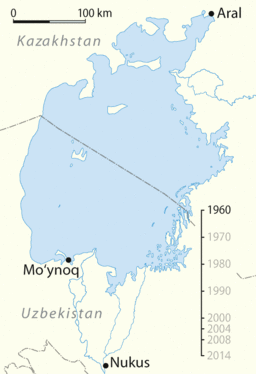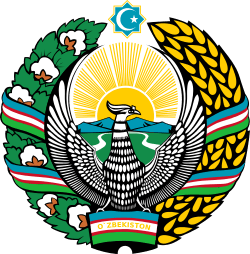Aralkum Desert
| Aralkum | |
| Desert | |
 Aralkum with the remaining areas of the Aral Sea in 2014 | |
| Countries | Uzbekistan, Kazakhstan |
|---|---|
 Animated map of the shrinking of the Aral Sea, and growing Aralkum
| |
The Aralkum Desert is a new desert that has appeared since 1960 on the seabed once occupied by the Aral Sea.[1] It lies to the south and east of what remains of the Aral Sea in Uzbekistan and Kazakhstan.
History
While the level of the Aral Sea has fluctuated over its existence, the most recent level drop since the 1960s[2] was caused by the former Soviet Union building massive irrigation projects in the region. The severely reduced inflow subsequently caused the water level in the Aral Sea to drop. While the North Aral Sea is rising due to a dike, the South Aral Sea kept dropping, thus expanding the size of the desert, until 2010, when the South Aral Sea was partly reflooded. The water level of the South Aral Sea then began to drop again, however this time more severely.
Airborne contaminants

The sands of the Aralkum and the dust that originates from it contain pollutants.[3] The desert's location on a powerful east-west airstream has resulted in pesticides in the dust being found in the blood of penguins in Antarctica.[4] Aral dust has also been found in the fields of Russia, the forests of Norway, and in the glaciers of Greenland.[5]
See also
References
- ↑ Aral Sea State of Environment of the Aral Sea Basin. Regional report of the Central Asian States. (2000) Archived 24 April 2008 at the Wayback Machine.
- ↑ "Aral Sea Tours from 450 USD: your Travel to the Aral Sea will be unforgettable with Peopletravel!".
- ↑ Pandey, Anish Chandra; Jha, Niraj K (2007). "CENTRAL ASIA: DEMOCRATIC DEFICIT AND CHALLENGES OF SUSTAINABLE DEVELOPMENT". Journal of Environmental Research And Development. Jerad Publcation. 1 (4): 403–411. Retrieved 11 February 2016.
Salt, sand, and dust from exposed Aral Sea mud beds blow across the region, harming people and crops. The excessive use of pesticides and fertilizers from farms has poisoned food and drinking water. The human cost of the crisis has been high in the Aral Sea area. For instance, infant mortality rates have consistently been the highest in the former Soviet Union
- ↑ Nurushev, A (April 1999). "CRISIS OF THE ARAL SEA". Himalayan and Central Asian Studies. Himalayan Research and Cultural Foundation. 3 (2): 50–58. Retrieved 11 February 2016.
... The effect of pollution is aggravated by the fact that the Aral Sea is situated on the "highway" where strong currents of air are blowing from the west to the east. ... That is why pesticides from the Aral region are found in the blood of penguins living in the Antarctic continent. ...
- ↑ "Archived copy". Archived from the original on 1 February 2016. Retrieved 2016-05-24. "...typical Aral dust has been found on Greenland's glaciers, in Norway's forests, and Byelorussia's fields, all situated thousands of kilometers away from Central Asia."
External links
| Wikimedia Commons has media related to Aralkum Desert. |
- Siegmar-W. Breckle: Combating desertification and rehabilitation of the salt deserts in the region at the Aral Sea
- Walter Wucherer: Primary succession on the dry sea floor of the Aral Sea
Coordinates: 44°40′N 60°40′E / 44.667°N 60.667°E

